Charles IV of Spain
| Charles IV | |||||
|---|---|---|---|---|---|
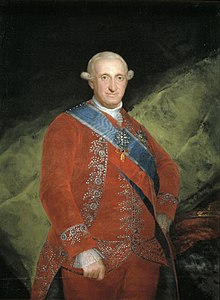 Portrait byFrancisco Goya,1789 | |||||
| King of Spain | |||||
| Reign | 14 December 1788 –19 March 1808 | ||||
| Predecessor | Charles III | ||||
| Successor | Ferdinand VII | ||||
| Chief ministers | See list
| ||||
| Born | 11 November 1748 Palace of Portici,Portici,Naples | ||||
| Died | 20 January 1819(aged 70) Palazzo Barberini,Rome,Papal States | ||||
| Burial | |||||
| Spouse | |||||
| Issue | |||||
| |||||
| House | Bourbon | ||||
| Father | Charles III of Spain | ||||
| Mother | Maria Amalia of Saxony | ||||
| Religion | Catholic Church | ||||
| Signature |  | ||||
Charles IV(Spanish:Carlos Antonio Pascual Francisco Javier Juan Nepomuceno José Januario Serafín Diego de Borbón y Sajonia;11 November 1748 – 20 January 1819) wasKing of Spainand ruler of theSpanish Empirefrom 1788 to 1808.
The Spain inherited by Charles IV gave few indications of instability,[1]but during his reign, Spain entered a series of disadvantageous alliances and his regime constantly sought cash to deal with the exigencies of war. He detested his son and heirFerdinand,who led the unsuccessfulEl Escorial Conspiracyand later forced Charles's abdication after theTumult of Aranjuezin March 1808, along with the ouster of his widely hated first ministerManuel de Godoy.Summoned toBayonnebyNapoleon Bonaparte,who forced Ferdinand VII to abdicate, Charles IV also abdicated, paving the way for Napoleon to place his older brotherJoseph Bonaparteon the throne of Spain. The reign of Charles IV turned out to be a major turning point in Spanish history.[2][3]
Early life[edit]
Charles was the second son ofCharles IIIand his wife,Maria Amalia of Saxony.He was born inNaples(11 November 1748), while his father wasKing of NaplesandSicily.His elder brother,Don Felipe,was passed over for both thrones, due to his learning disabilities andepilepsy.In Naples and Sicily, Charles was referred to as thePrince of Taranto.[4]He was calledEl Cazador(meaning "the Hunter" ), due to his preference for sport and hunting, rather than dealing with affairs of the state. Charles is considered by historianStanley G. Payneas "good-hearted but weak and simple-minded."[5] On 18 November 1791,King Carlos IVpromulgated a royal decree declaring the foundation of the "Royal University of Guadalajara".[6]in modern timesUniversity of Guadalajara.
Reign[edit]


In 1788, Charles III died and Charles IV succeeded to the throne and ruled for the next two decades. Even though he had a profound belief in the sanctity of the monarchy and kept up the appearance of an absolute, powerful king, Charles never took more than a passive part in his own government. The affairs of government were left to his wife,Maria Luisa,and the man he appointed first minister,Manuel de Godoy.Charles occupied himself withhuntingin the period that saw the outbreak of theFrench Revolution,the executions of his Bourbon relativeLouis XVI of Franceand his queen,Marie Antoinette,and the rise ofNapoleon Bonaparte.Ideas of theAge of Enlightenmenthad come toSpainwith the accession of the first Spanish Bourbon,Philip V.Charles' father, Charles III, had pursued an active policy ofreformthat sought to reinvigorate Spain politically and economically and make the Spanish Empire more closely an appendage of the metropole. Charles III was an active, working monarch with experienced first ministers to help reach decisions. Charles IV, by contrast, was ado-nothing king,with a domineering wife and an inexperienced but ambitious first minister, Godoy.[according to whom?]The combination of a king not up to the task of governance, the queen widely perceived to take lovers (including Godoy) and the first minister with an agenda of his own earned the monarchy increased alienation from its subjects.[7]
Upon ascending to the throne, Charles IV intended to maintain the policies of his father and, accordingly, retained his prime minister,the Count of Floridablanca.[5]Floridablanca avoided war with Great Britain in theNootka Sound crisis,where a minor trade and navigation dispute off the west coast ofVancouver Islandin 1789 could have blown up into a major conflict. Spain could have drawn on its French ally in support against Britain but they refused. In a humiliating move Floridablanca had no choice but to capitulate to British terms and therebynegotiated with them.In 1792, political and personal enemies ousted Floridablanca from office, replacing him with theCount of Aranda.However, in the wake of the war againstRepublican France,the liberal-leaning Count of Aranda was himself replaced byManuel de Godoy,a favorite of the Queen and widely believed to be her lover, who enjoyed the lasting favor of the King.[citation needed]
Under Charles IV,scientific expeditionscontinued to be sent by the crown, some of which were initially authorized byCharles III.TheRoyal Botanical Expedition to New Granada(1783–1816),[8]and theRoyal Botanical Expedition to New Spain(1787–1803),[9]were funded by the crown. TheMalaspina Expedition(1789–94) was an important scientific expedition headed by Spanish naval commanderAlejandro Malaspina,with naturalists and botanical illustrators gathering information for the Spanish crown.[10][11][12][13][14][15] In 1803, he authorized theBalmis Expedition,aimed atvaccinatingSpain's overseas territories againstsmallpox.[16]In 1799, Charles IV authorized Prussian aristocrat and scientistAlexander von Humboldtto travel freely in Spanish America, with royal officials encouraged to aid him in his investigation of key areas of Spain's empire. Humboldt'sPolitical Essay on the Kingdom of New Spainwas a key publication from his five-year travels.[citation needed]

Spain's economic problems were of long standing, but deteriorated further when Spain was ensnared in wars that its ally France pursued. Financial needs drove his domestic and foreign policy. Godoy's economic policies increased discontent with Charles's regime.[17]In an attempt to implement major economic changes,Gaspar Melchor de Jovellanos,a reformist,Jansenistconservative proposed major structural reform of land tenure to promote the revival of agriculture. His 1795 work,Informe en el expediente de ley agrariaargued that Spain needed thriving agriculture to allow its population to grow and prosper. In his analysis, the concentration of land ownership and traditions and institutional barriers were at the heart of agriculture's problems. He called for division and sale of public lands, which were held by villages, as well as the swaths of Spanish territory controlled by theMesta,the organization of livestock owners who had kept grazing lands as an asset for their use. Jovellanos also argued for the abolition of entailed properties (mayorazgos), which allowed landed estates to pass undivided through generations of aristocrats, as well as sale of lands held by the Catholic Church. The aim of these policies was to create in Spain yeoman farmers, who would pursue their self-interest and make agricultural land more productive. The cost would be to undermine the power of the Church and the aristocracy.[18]
As the situation with immediate revenue became more fraught, the crown in 1804 imposed measures in its overseas empire forcing the church to call in immediately the mortgages it had extended on a long-term by the Catholic Church. Although aimed at undermining the wealth and power of the church, the wealthy landowning elites were faced with financial ruin, since they had no way to make full payment on their mortgaged properties.[19]This ill-considered royal decree has been seen as a major factor in the independence movement inNew Spain(Mexico).[20]The decree was in abeyance once Charles and Ferdinand abdicated, but it undermined elite support while in force.
In foreign policy Godoy continued Abarca de Bolea's policy of neutrality toward as France, but after Spain protested the execution ofLouis XVI of Francein 1793, France declared war on Spain. After the declaration, Portugal and Spain signed a treaty of mutual protection against France.[21]In 1796 France forced Godoy toenter into an alliance,and declare war on theKingdom of Great Britain.As a consequence,Spainbecame one of themaritime empiresto have been allied with Republican France in theFrench Revolutionary War,and for a considerable duration.[22]
Spain remained an ally of France for a while, lost against the British in thebattle of Trafalgar,and supported theContinental Blockade.AfterNapoleon's victory overPrussiain 1807, Godoy kept Spain with the French side.
But the switching of alliances devalued Charles's position as a trustworthy ally, increasing Godoy's unpopularity, and strengthening thefernandistas(supporters ofCrown Prince Ferdinand), who favoured an alliance with theUnited Kingdom.[citation needed]
Economic troubles, rumors about a sexual relationship between the Queen and Godoy, and the King's ineptitude, caused the monarchy to decline in prestige among the population. Anxious to take over from his father, and jealous of the prime minister, Crown Prince Ferdinand attempted to overthrow the King in an aborted coup in 1807.[23]He was successful in 1808, forcing his father's abdication following theTumult of Aranjuez.
-
Coins with image of Charles IV of Spain, 1798
-
Coin of Charles IV of Spain Colombia 8 Escudos, 1794
-
Count de Floridablanca, painting byGoyaca. 1783
-
Count of Aranda
-
Manuel de Godoy, as general. Painting by Goya 1801
-
Gaspar Melchor de Jovellanos. Painting by Goya 1798
-
Crown Prince Ferdinand, Painting by Goya 1800
Abdications of Bayonne[edit]
Riots, and a popular revolt atthe winter palace Aranjuez,in 1808 forced the king to abdicate on 19 March, in favor of his son.[23]Ferdinand took the throne asFerdinand VII,but was mistrusted by Napoleon, who had 100,000 soldiers stationed in Spain by that time due to the ongoingWar of the Third Coalition.
The ousted King, having appealed to Napoleon for help in regaining his throne, was summoned before Napoleon inBayonne,along with his son, in April 1808. Napoleon forced both Charles and his son to abdicate, declared the Bourbon dynasty of Spain deposed, and installed his brother,Joseph Bonaparte,as King Joseph I of Spain, which began thePeninsular War.[24]
Later life and death[edit]
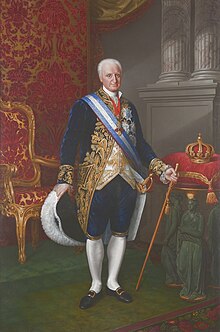
Following Napoleon's deposing of the Bourbon dynasty, the ex-King, his wife, and former Prime Minister Godoy were held captive in France first at thechâteau de Compiègne[25]and three years inMarseille(where a neighborhood was named after him).[26]After the collapse of the regime installed by Napoleon,Ferdinand VIIwas restored to the throne. The former Charles IV drifted about Europe[27]until 1812, when he finally settled inRome,in thePalazzo Barberini.[28][29][30][31]His wife died on 2 January 1819, followed shortly by Charles, who died on 20 January of the same year. SirFrancis Ronaldsincluded a detailed description of the funeral in his travel journal.[32][33]
Character[edit]
Well-meaning and pious, Charles IV floundered in a series of international crises beyond his capacity to handle.[27][according to whom?]He was painted byFrancisco Goyain a number of official court portraits, which numerous art critics have seen as satires on the King's stout vacuity.[34]
Marriage and children[edit]
Charles IV married his first cousinMaria Louisa,the daughter of Philip, Duke of Parma, in 1765. The couple had fourteen children, seven of whom survived into adulthood:
| Children of King Charles IV | |||
|---|---|---|---|
| Name | Portrait | Lifespan | Notes |
| Carlos Clemente Infante of Spain |
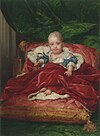
|
19 September 1771 – 7 March 1774 | Born and died atEl Escorial;baptized on the same day he was born, with Charles III representing "the Holy Father" at the christening.Pope Clement XIVcelebrated Carlos' birth and sent the infant consecrated swaddling clothes.[35] |
| Carlota Joaquina Queen of Portugal and the Algarves |

|
25 April 1775 – 7 January 1830 | Born at theRoyal Palace of Aranjuez,she married her first cousinJohn VI of Portugalin 1785 and became Queen consort of Portugal in 1816. Had issue, including the futurePedro I of Brazil.She died atQueluz National Palace. |
| Maria Luisa Infanta of Spain |
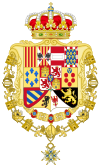
|
11 September 1777 – 2 July 1782 | Born and died at theRoyal Palace of La Granja de San Ildefonso.[36] |
| María Amalia Infanta of Spain |
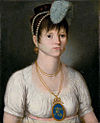
|
9 January 1779 – 22 July 1798 | Born at the Royal Palace of Aranjuez, she married her uncleInfante Antonio Pascual of Spainin 1795. She gave birth to a stillborn son in 1798 and died shortly thereafter. |
| Carlos Domingo Infante of Spain |
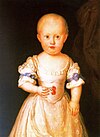
|
5 March 1780 – 11 June 1783 | Born at theRoyal Palace of El Pardoand died at the Royal Palace of Aranjuez.[36]After his birth, his father pardoned all of the convicts fromPuerto San Juliánas a sign of celebration.[37] |
| Maria Luisa Queen of Etruria Duchess of Lucca |

|
6 July 1782 – 13 March 1824 | Born at the Royal Palace of La Granja de San Ildefonso, she married her first cousinLouis, King of Etruriain 1795 and had issue, includingCharles II, Duke of Parma.Became Duchess of Lucca in her own right in 1817 and died inRomein 1824 of cancer. |
| Carlos Francisco de Paula Infante of Spain |

|
5 September 1783 – 11 November 1784 | Twins, born and died at the Royal Palace of La Granja de San Ildefonso.[38]Their birth was an important event for the people of Spain and provided security for the succession, a security which was truncated with the early deaths of Carlos and Felipe.[39] |
| Felipe Francisco de Paula Infante of Spain |
5 September 1783 – 18 October 1784 | ||
| Fernando (VII) King of Spain |
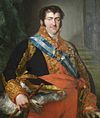
|
14 October 1784 – 29 September 1833 | Born and died at El Escorial, he succeeded his father as King in 1808, but was deposed byJoseph Bonaparteone month later. Married his first cousinPrincess Maria Antonia of Naples and Sicilyin 1802, no issue. Re-instated as King in 1813. Married his nieceMaria Isabel of Portugalin 1816, had issue. MarriedMaria Josepha Amalia of Saxonyin 1819, no issue. Married his nieceMaria Christina of the Two Siciliesin 1829 and had issue, including the futureIsabella II of Spain.Died in 1833. |
| Carlos María Isidro Benito Count of Molina |
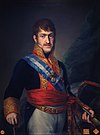
|
29 March 1788 – 10 March 1855 | Born at the Royal Palace of Aranjuez. Married his nieceInfanta Maria Francisca of Portugalin 1816 and had issue. Married his nieceMaria Teresa, Princess of Beirain 1838, no issue. FirstCarlistpretender to the throne of Spain as "Carlos V". Use the title "Count of Molina" between 1845 and his death in 1855. |
| María Isabel Queen of the Two Sicilies |

|
6 July 1789 – 13 September 1848 | Born at theRoyal Palace of Madrid,she married her first cousinFrancis I of the Two Siciliesin 1802 and had issue, including the futureFerdinand II of the Two Sicilies.Queen consort between 1825 and 1830, her husband's death. Died at thePalace of Porticiin 1848. |
| Maria Teresa Infanta of Spain |
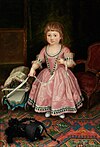
|
16 February 1791 – 2 November 1794 | Born at the Royal Palace of Aranjuez and died at El Escorial[40]ofsmallpox.[41] |
| Felipe Maria Infante of Spain |
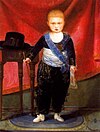
|
28 March 1792 – 1 March 1794 | Born at the Royal Palace of Aranjuez and died at the Royal Palace of Madrid.[40] |
| Francisco de Paula | 
|
10 March 1794 – 13 August 1865 | Born at the Royal Palace of Aranjuez, he married his niecePrincess Luisa Carlotta of Naples and Sicilyin 1819 and had issue. Died in Madrid in 1865. |
Ancestors[edit]
See also[edit]
References[edit]
- ^Lynch, John.Bourbon Spain, 1700–1808.Basil Blackwell 1989, p. 375
- ^Lynch, "Charles IV and the Crisis of Bourbon Spain", Chapter 10,Bourbon Spain.
- ^"Charles IV of Spain and His Family hides a rulers caricature".Hypercritic.Retrieved19 March2023.
- ^Almanach royal, p 34
- ^abStanley G. Payne,History of Spain of Portugal,Vol 2, University of Wisconsin Press., 1973,ISBN978-0-299-06284-2,page 415
- ^University of Guadalajara."I. The Royal University of Guadalajara, 1791 – 1821".Retrieved3 June2015.
- ^Lynch,Bourbon Spain,376-77
- ^Pérez Arbeláez, Enrique (1983) [1967].José Celestino Mutis y la real expedición botánica del Nuevo Reyno de Granada(in Spanish) (2nd. ed.). Bogotá: Instituto Colombiano de Cultura Hispánica.
- ^Rickett, Harold W. (1947). "The Royal Botanical Expedition to New Spain".Chronica Botanica.11(1): 1–81.
- ^Bleichmar,Visible Empire,pp. 16–18.
- ^La expedición Malaspina 1789–1794.9 vols. Madrid: Lunwerg Editores 1987–96.
- ^Andrés Galera Gómez,La ilustración española y el conocimiento del nuevo mundo. La ciencias naturales en la expedición Malaspina (1789–1994): La labor científica de Antonio Pineda.Madrid: CSIC 1988.
- ^Dolores Higueras Rodríguez (ed.)La Botánica en la Expedición Malaspina 1789–1794.Madrid: Turner Libros 1989.
- ^Juan Pimentel,La física de la monarquía. Ciencia y política en el pensamiento colonial de Alejandro Malaspina (1754–1810). Madrid: Doce Calles 1998.
- ^María Pilar de San Pío Aladrén and María Dolores Higueras Rodríguez (eds.)La armonía natural. La naturaleza en la expedición marítima de Malaspina y Bustamante (1789–1794).Madrid: Lunverg Editores 2001.
- ^Carlos Franco-Paredes; Lorena Lammoglia; José Ignacio Santos-Preciado (2005)."The Spanish Royal Philanthropic Expedition to bring Smallpox vaccination to the New World and Asia in the 19th Century".Clinical Infectious Diseases.41(9). Oxford Journals: 1285–1289.doi:10.1086/496930.PMID16206103.
- ^Burkholder, Suzanne Hiles. "Charles IV of Spain" inEncyclopedia of Latin American History and Culture.Vol. 2, p. 82. New York: Charles Scribner's Sons 1996.
- ^Brading, D.A.The First America: The Spanish monarchy, Creole patriots, and the Liberal state, 1492-1867.Cambridge: Cambridge University Press 1991, pp. 510-11.
- ^Hamnett, Brian R. "The Appropriation of Mexican Church Wealth by the Spanish Bourbon Government--The Consolidación de Vales Reales', 1805-1809." Journal of Latin American Studies 1.2 (1969): 85-113.
- ^Von Wobeser, Gisela. "La consolidación de vales reales como factor determinante de la lucha de independencia en México, 1804-1808." Historia mexicana (2006): 373-425.
- ^Portugal; de), José Ferreira Borges de Castro (Visconde; Biker, Julio Firmino Judice; Estrangeiros, Portugal Ministério dos Negócios (19 June 2018)."Supplemeto á Collecção dos tratados, convenções, contratos e actos publicos celebrados entre a corôa de Portugal e as mais potencias desde 1640".Imprensa nacional – via Google Books.
- ^Ollie Bye (3 February 2016)."The French Revolutionary Wars: Every Other Day".Archivedfrom the original on 13 November 2021 – via YouTube.
- ^abPayne, page 420
- ^Griffin, Julia Ortiz; Griffin, William D. (2007).Spain and Portugal:A Reference Guide from the Renaissance to the Present.Facts on File. p.151.ISBN978-0-8160-4592-1.
- ^Alain Raisonnier, Claudie Ressort (2009) Le séjour de Charles IV et de la Cour d'Espagne au Palais de Compiègne en 1808-1809, Annales Historiques compiégnoises, n° 113-114, pp. 14-24
- ^Paul Gaffarel (1919) Le séjour de Charles IV d'Espagne à Marseille, Revue des Etudes Napoléoniennes, t. XVI, pp. 40-57
- ^abGriffin, page 152
- ^fr:Charles IV d'Espagne
- ^Manuel de Godoy#Exile
- ^WorldrootsArchived11 May 2004 atarchive.today
- ^"The Royal Favorite: Manuel Francisco Domingo de Godoy, Prince of the Peace".napoleon-series.org.
- ^Ronalds, B.F. (2016).Sir Francis Ronalds: Father of the Electric Telegraph.London: Imperial College Press. p. 188.ISBN978-1-78326-917-4.
- ^"Sir Francis Ronalds' Travel Journal: Naples and Pompeii".Sir Francis Ronalds and his Family.Retrieved23 February2018.
- ^Edward J. Olszewski (1999). "Exorcising Goya's" The Family of Charles IV "".Artibus et Historiae.20(40): 169–185.doi:10.2307/1483673.JSTOR1483673.
- ^von Pastor, Ludwig Freiherr (1952).The History of the Popes, from the Close of the Middle Ages.Michigan: Kegan Paul. p. 201.
- ^abReal Academia Matritense de Heráldica y Genealogía (2007).Anales de la Real Academia Matritense de Heráldica y Genealogía. Vol. X.(in Spanish). Madrid: RAMHG. p. 330.
- ^Senatore, Mar'a Ximena (2007).Arqueolog'a e historia en la colonia espa–ola de Floridablanca, Patagonia, siglo XVIII(in Spanish). Madrid: Teseo. p. 149.ISBN978-987-1354-08-5.
- ^Real Academia Matritense de Heráldica y Genealogía (2007).Anales de la Real Academia Matritense de Heráldica y Genealogía. Vol. X.(in Spanish). Madrid: RAMHG. p. 332.
- ^Palazón, Juan Manuel Abascal (2010).José Vargas Ponce (1760–1821) en la Real Academia de la Historia(in Spanish). Madrid: Real Academia de la Historia. p. 54.ISBN978-84-15069-00-3.
- ^abHilt, Douglas (1987).The Troubled Trinity: Godoy and the Spanish Monarchs.Alabama: University of Alabama Press. p. 292.ISBN978-0-8173-0320-4.
- ^Zavala, José María (2013).La maldición de los Borbones(in Spanish). Mexico: Random House Mondadori. p. 16.ISBN978-84-01-34667-5.
- ^Genealogie ascendante jusqu'au quatrieme degre inclusivement de tous les Rois et Princes de maisons souveraines de l'Europe actuellement vivans[Genealogy up to the fourth degree inclusive of all the Kings and Princes of sovereign houses of Europe currently living] (in French). Bourdeaux: Frederic Guillaume Birnstiel. 1768. p. 9.
Further reading[edit]
- Barbier, Jacques A. "Peninsular finance and colonial trade: The dilemma of Charles IV's Spain." Journal of Latin American Studies 12.1 (1980): 21–37.
- Gómez de Arteche.Historia del Reinado de Carlos IV,(5 vols.), in theHistoria General de España de la Real Academia de la Historia(Madrid, 1892).
- Hamilton, Earl J. "Monetary problems in Spain and Spanish America 1751–1800." The Journal of Economic History 4.1 (1944): 21–48.
- Paquette, Gabriel B.Enlightenment, governance, and reform in Spain and its empire, 1759–1808.New York: Palgrave Macmillan, 2008.
- Russell, Craig H. "Spain in the Enlightenment."The Classical Era.Palgrave Macmillan, London, 1989. 350–367.
External links[edit]
- .Encyclopædia Britannica(11th ed.). 1911.
- .The American Cyclopædia.1879.
- Historiaantiqua.Isabel II; (Spanish)(2008)
- Charles IV of Spain
- 1748 births
- 1819 deaths
- 18th-century Spanish monarchs
- 19th-century Spanish monarchs
- 18th-century Navarrese monarchs
- 19th-century Navarrese monarchs
- Princes of Asturias
- House of Bourbon (Spain)
- People from Portici
- Knights of Santiago
- Knights of the Golden Fleece of Spain
- Grand Crosses of the Order of Christ (Portugal)
- Grand Crosses of the Order of Aviz
- Grand Crosses of the Order of Saint James of the Sword
- Neapolitan princes
- Sicilian princes
- Burials in the Pantheon of Kings at El Escorial
- 18th-century Roman Catholics
- 19th-century Roman Catholics
- Grand Masters of the Order of the Golden Fleece
- Spanish captain generals
- Monarchs who abdicated
- People of the War of the First Coalition
- Children of Charles III of Spain








